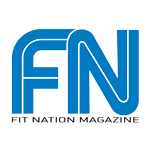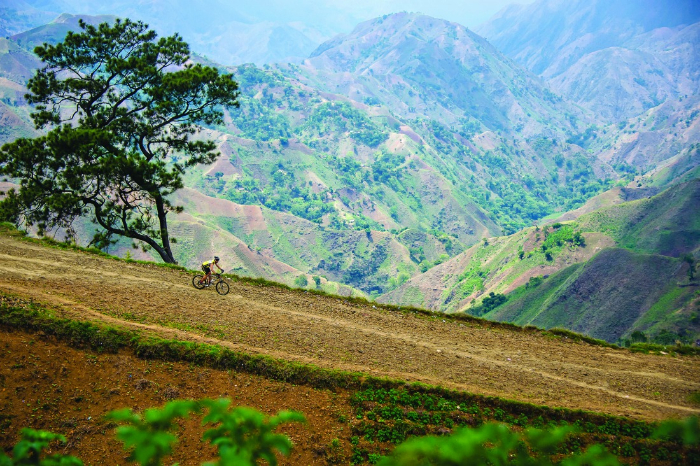On Jan. 29, 2013, 26 amateur and professional mountain bikers from around the world flew to Haiti to participate in the first-ever MTB Ayiti Ascent Stage Race, a once-in-a-lifetime opportunity to blend authentic cultural immersion with an insanely challenging mountain bike course through some of the most rugged—and breathtaking—terrain in the Western hemisphere.
But MTB Ayiti is more than just a race; it’s part of a bigger picture. The goal is twofold: to give extreme sports tourists a chance to explore Haiti by bike and, in turn, to begin building a sustainable adventure tourism market in the economically devastated country.
When word of this unique excursion made its way to Naples, Jill Wheeler knew she had to be there. Wheeler, the founder of Wellfit Institute, a holistic center for yoga, fitness, wellness and adventure in Naples, joined the MTB Ayiti team in January as its wellness contingent, bearing a tangible gift of 40 donated yoga mats as well as an intangible one: her knowledge of massage therapy and bodywork and, more importantly, how to market them. By helping create a niche in an emerging market for a small team of Haitian workers, she enabled them to transform their newfound knowledge into a chance at a new career.
Here, Wheeler shares her weeklong journey through Haiti’s rocky mountain ranges, river valleys and coastal plains, all in the name of goodwill and the ultimate adventure.
Jan. 29: Pre-race
My husband I had planned to travel to Haiti together since he was going to be riding in the race. We arrived in Miami the night before because our flight was scheduled for early the next morning. Once we got there, he noticed that his passport was expired, which meant we wouldn’t be able to fly out at the same time.
It was definitely a bit hectic, but it was a testament to how yoga has transformed my life. It didn’t stress me out; it was just, “OK, this is what it is, and its not going to be a big deal.”
I had done a lot of prep work before the trip, so my main focus on that first day was to meet the staff in Haiti I had been coordinating with for the past few months. Once I landed, it was all about logistics. I didn’t have a phone, so it was just messages and email, searching for a Wi-Fi signal and trying to connect.
I had been to Haiti the year before, and I knew what to expect, so I wasn’t stressed about that. But the race had a lot of moving parts, and I knew going into this that I was going to have to be my own director. I had three Haitian therapists and body workers scheduled to work with me during the race, so my goal was to just get there, find a way to communicate and set up a plan.
Once I arrived at the hotel and met my team I went to visit Project Zen, the only yoga studio in Haiti, in what I call the kinder, gentler version of Port-au-Prince. I had wanted to give a yoga session that day, but the yoga mats that had been donated were still sitting in a shipping container at customs, so unfortunately that didn’t happen.
Jan. 30: Day 1
The race was scheduled for four days, but the first two were called ecosystems building stages, held in Port-au-Prince. It was a mandatory activity for the bikers, and if they didn’t participate, they would lose time off their race. So they couldn’t just go and impress everyone with their bike skills; they had to actually help improve Haiti.
The goal of MTB Ayiti isn’t just to have a mountain bike race in Haiti. The goal is also to have a usable trail so that the average adventure tourist could visit Haiti independently and follow these trails. As part of the ecosystems building we helped create trail markers for future tourists through the The Global Mosaic Project, a program that works directly with communities to create permanent, public artworks that enhance the sites where they’re located—and, in this case, they were functional, too.
We spent hours working on the mosaic art, and it was cool to see the juxtaposition of all these athletes working with their hands and creating all this art. My local massage team got to be a part of it, too, which was nice, because they were able to help give back to their country.
After they finished working on the Mosaic Project for the day, some of the bikers went and helped local kids set up bikes, while others visited the local schools.
Jan. 31: Day 2
On the second day we continued with the Mosaic Project. Half of the racers were sponsored, and some of those riders were part of a Haitian riding team from a town called Léogâne, which is where the devastating earthquake in January 2010 struck the hardest.
For the race, these Léogânean riders were all given brand-new bikes, and their entry fees were sponsored, which was wonderful. They joined us in the Mosaic Project, and it was empowering to see them take pride in helping their country.
After the Mosaic activity, we had some downtime, so people started to put their bikes together. We did a meditation session and then a yoga practice by the pool of the hotel.
That night, we had a private dinner with the Ministry of Tourism. Afterwards, we watched a local hip-hop dance group that had come from one of the most impoverished areas in the Caribbean. It was great for the people in Haiti to see that there were people in their region doing these cool things.
After the send-off dinner, I could tell people were starting to stress out about their bodies and wanted some bodywork. I realized it was time to get organized and set everything up.
I had been told by race directors that the Haitians wouldn’t want any bodywork done, but they were lining up with the rest of the bikers! They asked for it just as much as the Americans. So I brought out my rolling pin and stayed busy that night, rolling and massaging people’s necks, legs and glutes to help them feel strong and ready for the grueling day ahead.
Feb. 1: Day 3
On Friday we got up early. You could feel the energy. People were starting to get nervous. We didn’t do any yoga or meditation that morning; there just wasn’t time. We had to load up the ATVs and start the long drive around the mountain to meet the bikers at the campsite.
Eight hours later, we arrived at the camp. All of the tents were set up, but there was no running water. Apparently the man who was running the setup hadn’t given the locals any money from this event, so they had retaliated by cutting off the water supply. It was definitely a little rough for everyone.
That night my team and I did a lot of treatments, and we created a little wellness center. I was there not just for bodywork but also for wellness, so I went around talking to people to see if they were hungry or tired and just listening to them. We had this little stone house, which became a refuge, and people were just so happy sitting inside. We had candles lit; it was very calm and quiet; and the riders could get massages and bodywork done. I was proud of my team—they worked hard for around seven hours, just giving treatments.
It had been a hard ride, but the riders were psyched, and the energy was high. By the time everyone got in, it was cold and dark, so we skipped the yoga class and just focused on our work in the wellness center that day.
Feb. 2: Day 4
On the last morning of the race, I got up at 5 a.m. and went on a crazy trail run by myself. Then I taught a yoga class to the group before we all took off. My team and I left first to clear the way for the bikers. I wanted to get to get a head start to the finish line to see my husband and friends cross that finish line. It was a busy morning!
We reached the finish line in about five hours, but the massage tables didn’t get there until hours after we did, which was not ideal. I could have run four or five more wellness sessions in that time, but with huge organizations like this, there are so many little details that it’s hard to get everything perfect.
That last night was amazing. We had a big awards ceremony and dinner, and the Ministry of Tourism came to celebrate with us. Carnival celebrations would be taking place the following week, so we had a pre-carnival party in honor of the event.
During the ceremony, I made a point to introduce my team. They got up and spoke about themselves and their dreams for Haiti. They spoke in English and Creole, and it was amazing to hear their stories and see the results of this experience for them. They were exposed to all these new networking opportunities for jobs in Haiti, which was definitely a part of the bigger picture of this event.
Feb. 3: Heading Home
For me, the MTB Ayiti program wasn’t just about doing a race and having the racers feel good and get massages. It was about creating a template for work for the Haitian locals. It was about showing them that this is what a world-class race looks like, and these are the skills needed to execute this type of service.
Basically, I created a mentoring program so the locals could have a bit of experience and learn about the business aspect of adventure-based wellness, build some contacts and also gain some materials, thanks to the donated yoga mats we brought along.
The race will be happening again next year, and I plan to facilitate some sort of aspect. I would love to get one of the Haitian team members to run it on location, because at the end of it all, that would be one more component that makes MTB Ayiti a true, lasting success.
INFO
Want to ride, sponsor or volunteer in 2014? Get all the details at mtbayiti.org.
Ayiti by the numbers
Wellness team members: 3
Treatments given: 60
Yoga mats donated: 40
Yoga and meditation participants: 32


